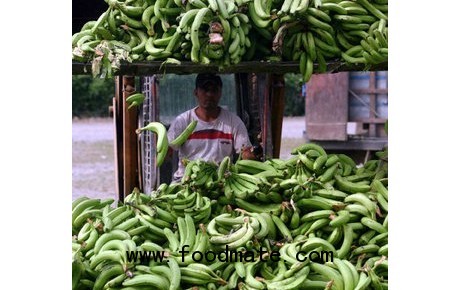
Ecuador Bananas, the world’s most traded fruit, are getting more expensive after Latin American rains that were 60 percent above normal in Ecuador curbed output.
Exports from Ecuador, the world’s biggest shipper, may drop 10 percent this year, said Eduardo Ledesma, executive director of the Ecuadorean Banana Exporters’ Association. Rain damaged crops especially in Los Rios, the top producing province, he said.
While Ecuador’s export prices have dropped 16 percent from a record in March, they still are 35 percent higher than the 10-year average, according to International Monetary Fund data.
Banana exports rose to the highest level in at least a decade last year, making it the most-traded fruit, ahead of citrus, apples and pears, according to the World Trade Organization. Dublin-based Fyffes said this month it plans to raise prices because of higher fuel and fruit costs.
“Supply is relatively tight at the moment,” said Seamus Keenan, company secretary at Fyffes, Europe’s biggest banana supplier. “That’s to a large extent driven by some issues in Ecuador and Colombia, mainly weather issues.”
Good news for Chiquita
Tighter supplies and higher prices could be welcome news for Charlotte-based Chiquita Brands International. Low prices have hurt Chiquita, which recently announced it would cut $60 million worth of expenses and restructure in order to become a high-volume, low-cost commodity company.
In August, Chiquita reported that revenue fell 4 percent to $833 million for the second quarter, compared with the same period a year ago. Profits for the quarter plunged to $6 million, down 92 percent compared with the same quarter last year.
Ecuador declared a state of emergency in five provinces in March after above-average rainfall in the coastal region and southern Andean foothills washed away roads and houses and damaged more than 84,000 acres of crops, including the top three banana-producing regions in Los Rios, Guayas and El Oro.
Rainfall in Babahoyo, the capital of Los Rios province, was 60 percent higher than average in the seven months through August, according to data from Ecuador’s National Meteorology and Hydrology Institute in Quito. The region received 8.5 feet of rainfall between February and August.
Latin American supplies were down “rather significantly” in the first quarter, David A. DeLorenzo, chief executive officer of Westlake Village, Calif.-based Dole Food Co., said on a conference call July 19. Low prices paid to farmers may crimp world supplies, he said.
Fyffes ranks globally behind Dole, Chiquita and Fresh Del Monte Produce, it said in a Sept. 3 statement. Keenan declined to comment on the size and timing of the price increase.
Ecuador key part of supply chain
World production totaled 102.03 million metric tons in 2010, worth about $28.35 billion, according to the United Nations. Ecuador’s exports at 5.156 million tons accounted for 30 percent of global trade.
Ecuador produced 7.931 million tons of bananas in 2010, accounting for about 7.8 percent of world output, according to the United Nation’s Food and Agriculture Organization. The Latin American country’s harvest was the world’s fourth largest, after India, China and the Philippines.
Fyffes distributes 51 million cases of bananas annually, about one-third of leader Dole Food’s 154 million cases, according to a Sept. 3 presentation on the company’s website. A case weighs 40 pounds and holds about 100 bananas.
Fyffes started in 1888 and gets most of its bananas under long-term contracts with third-party producers.
Rain in Ecuador and Costa Rica has been near-normal to above-normal in the past 30 days, and the pattern may continue through November, Dale Mohler, a senior meteorologist with AccuWeather Inc., said by telephone from State College, Pa. Costa Rica is Latin America’s third-largest banana exporter after Ecuador and Colombia, according to the WTO.
Export prices for Ecuador’s bananas rose 1.1 percent in July, the biggest increase since they climbed to a record in March, International Monetary Fund data show. Demand tends to rebound during Northern Hemisphere fall and winter because of declining competition from locally grown fruit, helping to support prices, said Keenan of Fyffes.
Wet weather “has considerably affected the plants,” Ledesma of the exporters group said Sept. 5 by phone from the coastal city of Guayaquil. “The excess of rain and the current cold climate keep the fruit from ripening and reaching the right grade.”





